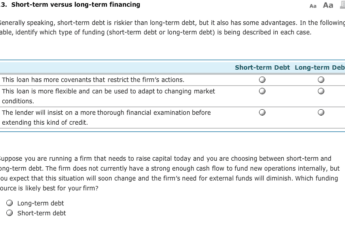There are advantages and disadvantages to short-term and long-term loans. You should carefully consider the loan duration to determine which is best for you. Short-term loans are best for small emergencies, while longer-term loans are best for larger expenses. Both types of loans are available online, and they all come with a range of interest rates and repayment terms.
Comparison between short-term loans and long-term loans
A short-term loan is one that must be repaid in six months to one year. A long-term loan, on the other hand, may take years to repay. Both types of loans may have different eligibility requirements and different rates of interest. Short-term loans often do not require any collateral, whereas long-term loans require a collateral. A short-term loan may be the most suitable choice if you are faced with a short-term cash crisis.
The key to deciding between short-term and long-term loans is to decide how much funding you need and what your repayment schedule will be. Generally speaking, a short-term loan is most appropriate for business expenses that can be paid for through your cash flow. A long-term loan, on the other hand, is more suitable if you need money for a larger business investment. Although long-term loans are generally more expensive over the life of the loan, they often offer more flexibility and lower monthly payments.
Another important factor to consider when deciding between short-term loans and long-term loan is their interest rates. Short-term loans typically have higher interest rates than long-term loans, but this is compensated by the shorter repayment terms. Additionally, short-term loans tend to carry lower risk because the loan period is shorter. However, borrowers with poor credit may have to make higher monthly payments, which can increase the overall costs of borrowing.
Another important factor to consider when choosing a loan is the charges and fees associated with it. Both short-term and long-term loans may come with set-up fees, as well as additional charges for repayment extensions. Banks may also charge early repayment fees. Short-term loans may be the best option for emergency cash needs, while long-term loans can be more useful for larger purchases and start-up expenses.

While short-term loans are more suitable for emergency situations and for short-term liquidity needs, long-term loans are essential for many businesses. Traditionally, long-term loans were only available to those with excellent credit and a long repayment schedule. However, the risk of defaulting on long-term loans is higher.
Interest rates
The interest rates on short term vs long term loan amounts vary widely. The difference is due to the length of the loan. Short-term loans are less expensive than long-term loans, and the lender can profit at lower rates. However, short-term loans are more risky because of the potential for loan default. Short-term loans are generally offered in smaller amounts and spread out over many years.
Interest rates on short term vs long-term loans vary widely between lenders. It’s important to compare different loans before making a final decision. Generally speaking, loans with shorter terms will have lower interest rates, but they also require higher monthly payments. If you have a good credit score, you’ll get a lower interest rate than if you took out a longer-term loan.
The loan amount is another factor determining which loan type is best for you. Long-term loans are usually larger amounts, and therefore more risky to provide. However, they can be useful if you’re in a business situation or need long-term funds for an important project. Long-term loans also come with longer repayment terms, which can save you a lot of money over the course of the loan.
If you need money fast, a short-term loan may be the better choice. In some situations, a higher interest rate on short-term loans will be worth the convenience of fast disbursement. On the other hand, short-term loans will often be harder to qualify for than long-term loans. If you’re unsure about the right loan type, take the time to complete a free pre-qualification application.
For medium-term loans, interest rates typically range from seven to thirty percent. These loans will have a repayment schedule that includes both the interest and principal. The lender usually stacks the interest bills on the earliest ones, so that over time the principal amount is gradually reduced.

Repayment timeframes
Long-term loans have a longer repayment period ranging from several years to decades. They are usually suited for larger amounts of capital, such as a home loan. While the interest rate on a long-term loan is lower than for a short-term loan, the total amount of interest paid over the loan’s life is higher. Some types of long-term loans include home loans, automobile loans, large personal loans, and hospitalization loans.
Short-term loans have much shorter repayment timeframes. Depending on the amount of money borrowed, a short-term loan can be repaid in as little as a few days or as long as one year. The exact timeframe is negotiated with the lender at the time of signing. Short-term loans are usually for smaller amounts of money, such as cash advance loans and payday loans.
Long-term loans, on the other hand, have stricter qualifications because they put the lending institutions at risk of default. Because of the higher risk of default, long-term loans can be beneficial if you need a large sum of money. However, long-term loans can be costly over time, so it is better to consider a shorter-term alternative if you need a larger amount.
Long-term business loans are available from both banks and online lenders. They usually have a shorter repayment period but higher interest rates. While long-term loans may cost more in the long run, the interest is generally not very high. This makes them a good choice for a small amount of money, especially for a startup or small business.
The length of the loan also influences the interest rate. Long-term loans are generally cheaper than short-term loans, as lenders have done more research on their borrowers. However, borrowers should do the math before choosing a long-term loan. While a low-interest rate might be attractive initially, it may end up costing them thousands of dollars over the years.
Risks
There are some risks that you need to consider before choosing a loan. Long-term loans may require you to provide collateral. This can be anything from real estate to cash or equipment. If you fail to repay the loan, the lender can liquidate the collateral to recover its losses. This can lead to a significant strain on your finances. Short-term loans, on the other hand, do not require collateral.

In addition, short-term loans can be riskier for your business. While short-term loans are often used to finance working capital, they are not without risks. A small company already has enough operational risk without adding financing risk to the mix. You have to know your company’s ability to absorb short-term debt and know when the financial risk is too great to accept.
Short-term loans usually have higher interest rates and less flexible repayment options. This is necessary to compensate for the shorter loan period and avoid the risk of default. Short-term loans may not be appropriate for borrowers with bad credit. Because the time to repay a short-term loan is so short, lenders may not want to lend a large amount.











